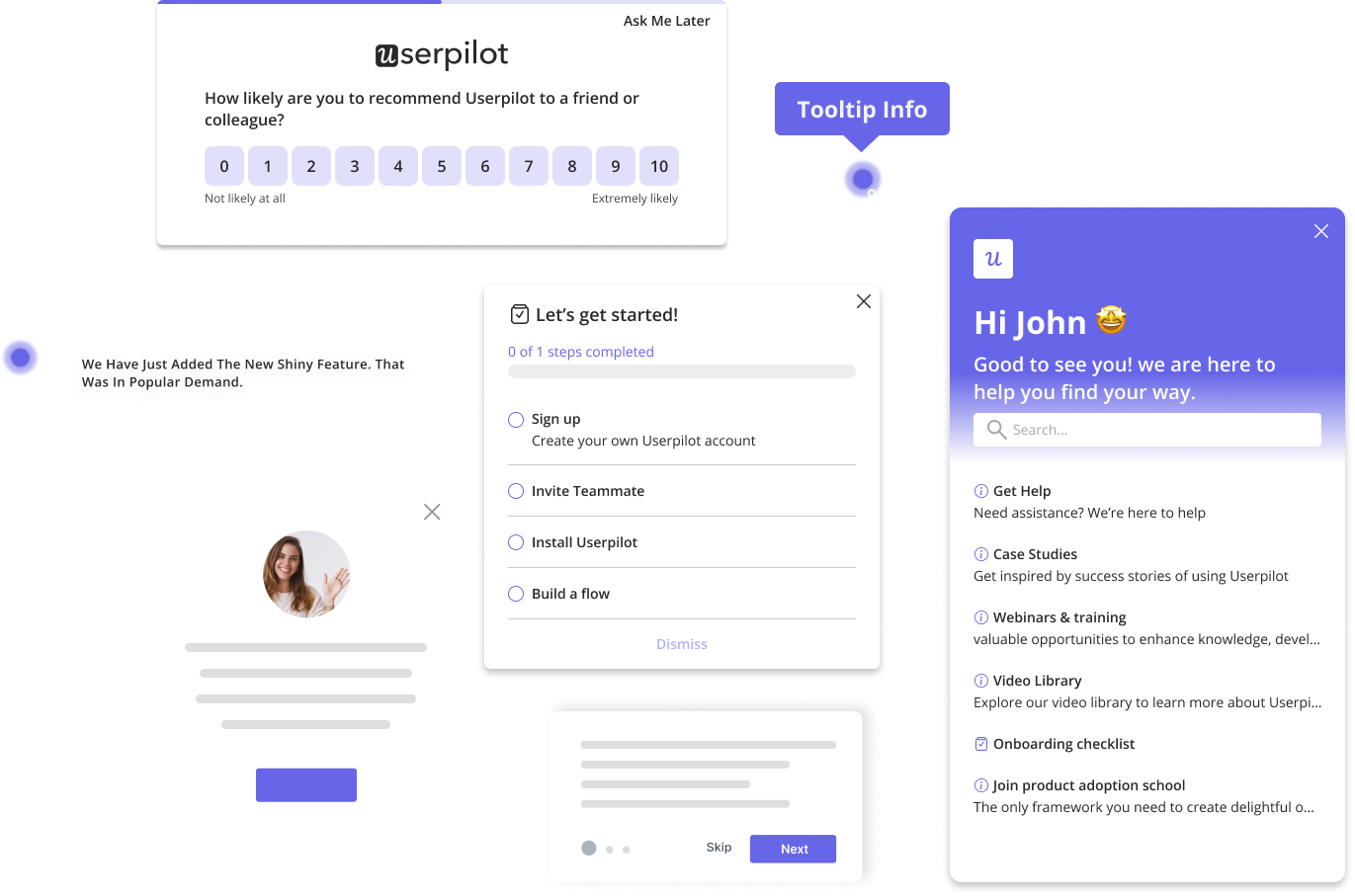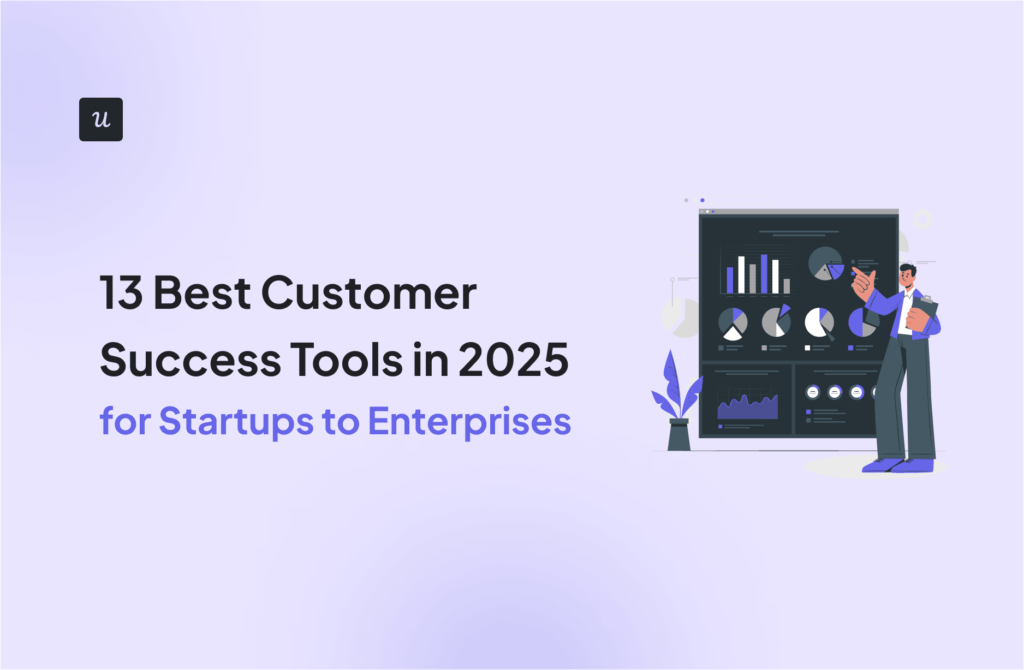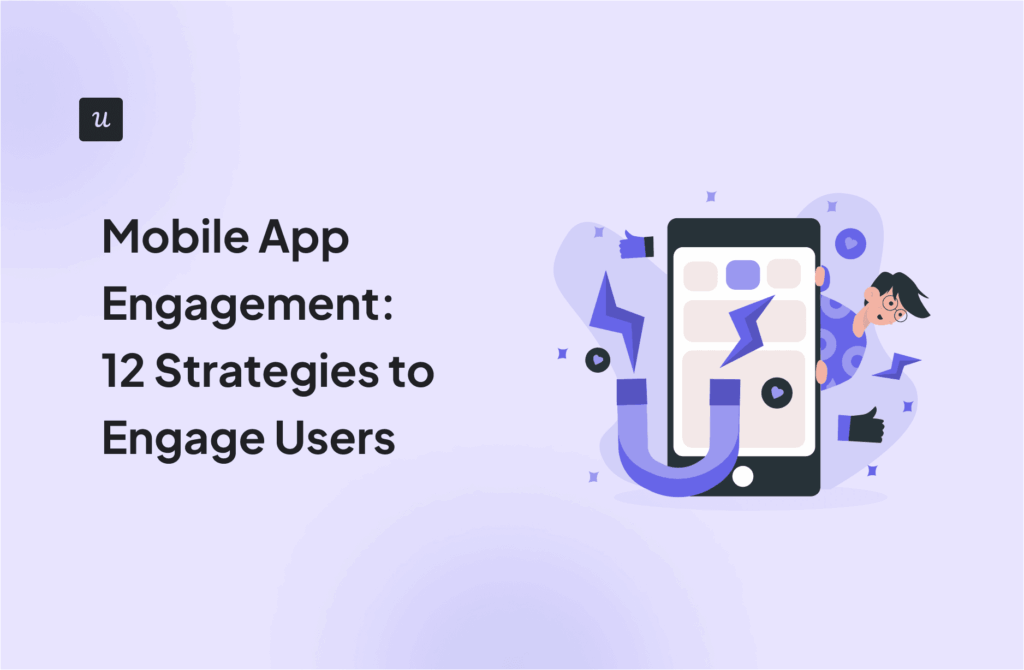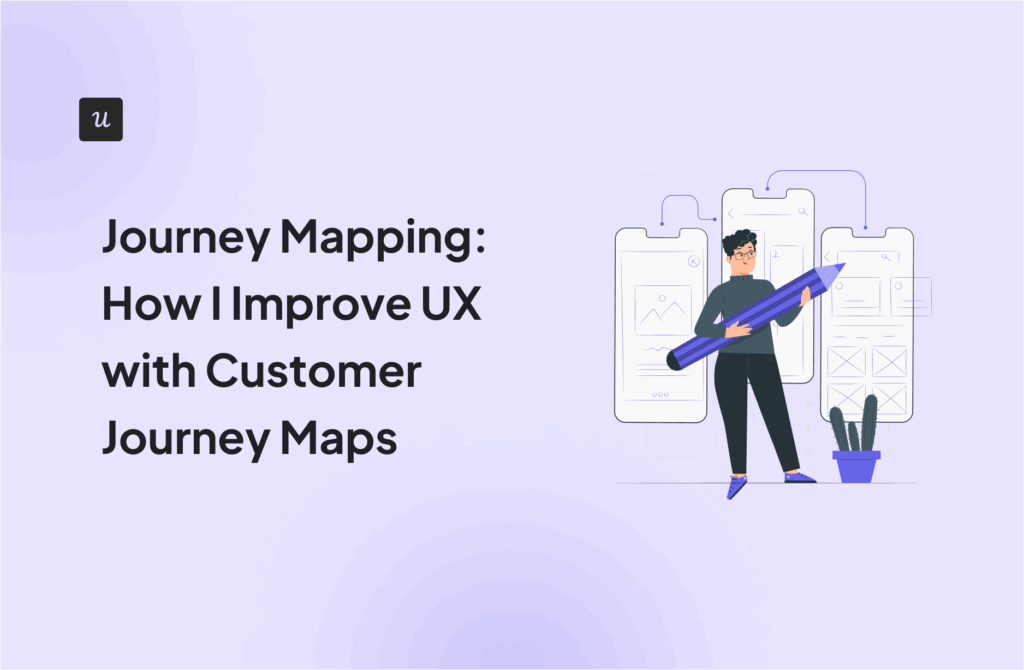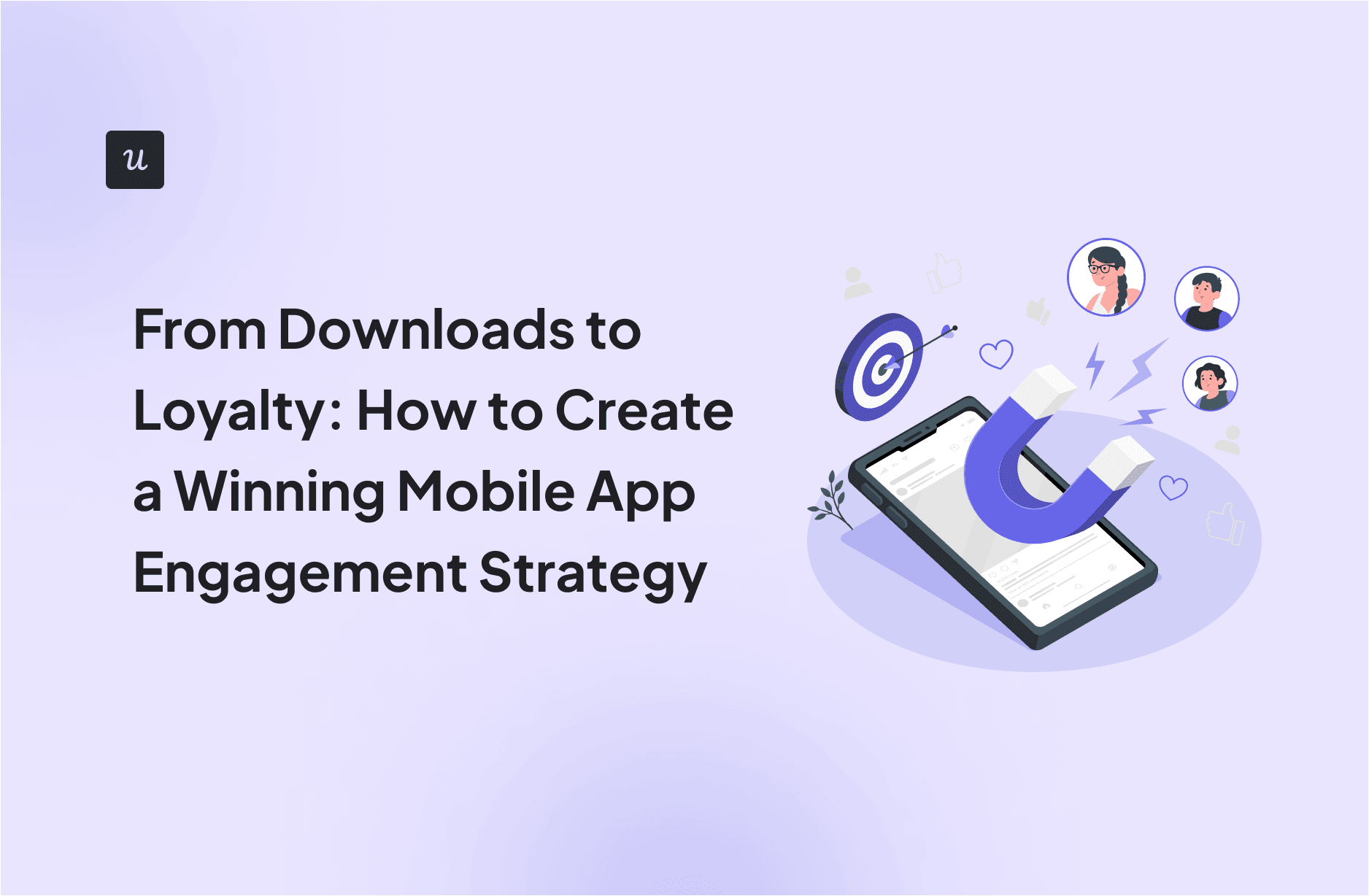
From Downloads to Loyalty: How to Create a Winning Mobile App Engagement Strategy
Did you know? According to a 2024 analysis, on average, over 95% of users who download a new mobile Android app abandon it within the first 30 days. This stark statistic underscores a simple truth: a solid mobile app engagement strategy is essential for your app’s success.
Put simply, app downloads are great but insufficient. In today’s congested app marketplace, the battle is won through sustained engagement. A successful mobile app must consistently transform fleeting interactions into lasting customer relationships.
The question is, “How?” In this article, I explore that question, highlighting key steps to create a mobile app engagement strategy and the best engagement techniques for mobile apps.
Try Userpilot Now
See Why 1,000+ Teams Choose Userpilot
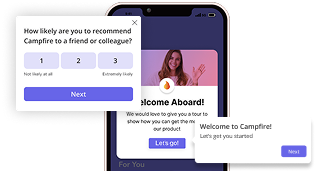
4 Key steps to building a successful mobile app engagement strategy
Building a successful user engagement strategy requires an in-depth understanding of your users and their goals with your product. I like to break this down into a 4-step process:
1. Clearly identify what ‘engagement’ means for your app
There’s simply no universal definition or metric for “user engagement.” This is because engagement is a highly contextual concept that depends on the specific goals of your app.
As a result, defining user engagement requires a holistic view encompassing user actions, retention, and business outcomes. To properly define it, ask yourself:
- What key actions do you want users to take regularly?
- What retention rates are you aiming for over different time frames?
- Which business outcomes are tied to user engagement?
Answering these questions will help you determine your North Star metric and the supporting metrics to track.
Let’s see how this works in practice…
Imagine you’ve created a guided meditation and mindfulness app. Your answers may look like this:
- Key user actions: Completing meditation sessions, exploring the content library, and completing daily mood reflections.
- Retention goals: 30% daily, 50% weekly, and 40% monthly.
- Related business outcomes: Increased subscription revenue, higher conversion rates, and referral growth.
Following your brainstorming session, your ideal user engagement metrics may look like this:
- Number of meditation sessions completed per user per week.
- Number of daily, weekly, and monthly active users.
- Daily, weekly, and monthly retention rates.
- Subscription conversion rate.
- Average session duration.
- Average content (articles, soundscapes, or programs) consumption per user.
Armed with these numbers, you can proceed to create a targeted engagement strategy that fuels business success and enhances user satisfaction.
2. Map out the complete user journey
Before moving on to the actual engagement strategy, pause to examine your app further. How do app users interact with it from the moment they download it and beyond?
To create this map, you must first outline key stages in the user’s journey, from initial app discovery to long-term usage. Next, identify key touchpoints (e.g., signup, onboarding, repeat usage, etc.) within those stages.
For each touchpoint, determine the user’s objectives, potential pain points, and moments of delight within the app.

If your app has multiple user personas with different needs and behaviors, ensure you map out the journeys of the most common personas.
By the end of this step, you should be able to design in-app engagement strategies for different user stages tailored to different personas.
3. Set up a framework to ensure repeated user engagement
Finally, it’s time to create a framework that keeps your app users returning. To effectively keep users engaged and boost retention, your strategy must include various techniques.
Think: personalization, in-app messaging, gamification, personalized push notifications, etc. We’ll explore all of these techniques in detail shortly.
For now, though, consider how Duolingo brings all this together with its comprehensive in-app engagement strategy. The strategy includes:

- Gamification: Duolingo turns learning into a game. Users earn experience points (XP), level up, and compete on leaderboards. Learning is also driven in stages, creating a sense of progress and accomplishment.
- Streaks: Duolingo rewards users for consistency, helping to foster a habit of daily learning. They also provide daily goals to encourage users to engage with the app.
- Tailored learning: Duolingo uses user data to adapt to individual learning styles and progress. They also provide personalized push notifications and recommendations to ensure relevance.
The result is an app that makes learning fun, engaging, and rewarding. Of course, there’s more to Duolingo’s strategy than just this, but this gives you an idea of how expansive it is.
4. Measure the effectiveness of your engagement strategy and iterate accordingly
Once you’ve implemented your strategy, you need to ensure it’s actually working as intended. To achieve this, you must regularly monitor your performance and adjust your strategy as needed.
There are two ways to monitor this performance:
1. Monitor mobile app engagement metrics
Remember those key metrics and performance indicators you set in Step 1? Track them using analytics tools that monitor user behavior and identify trends.
To see how much you’ve progressed, compare engagement data before and after implementing new strategies.

Then, compare them with industry standards to see how well you’ve performed relative to the competition.
2. Collect feedback from customers
Run in-app surveys and polls to understand how users feel about your engagement strategies. Rating surveys like NPS and CSAT can tell you how satisfied customers are with your product.
However, you also need qualitative feedback to help identify areas for improvement. You can get these insights through open-ended survey questions or by monitoring app store reviews and social media sentiment.
These free-form customer comments can reveal challenges in the user journey that you hadn’t even considered.
Tactics to follow to increase mobile app engagement
Now, let’s look more closely at the various techniques you can use to increase user engagement for mobile apps.
Keep the onboarding process short and focused
Did you know? Smartphone users are downloading more apps than ever (there were 257 billion app downloads in 2023 alone). Still, the average smartphone user only uses about 9 to 10 apps daily.
Therefore, your onboarding flow has to be short but meaningful to ensure users don’t abandon it in favor of those core attention-demanding apps.
There are four key ways to do just that:
- Identify essential features and prioritize them in your onboarding.
- Limit onboarding to 3-5 essential steps only.
- Use progress indicators to show users how far they’ve come.
- Offer a “skip” option for users already familiar with your product.
Thankfully, Userpilot now offers a reasonably simple way to create short but engaging onboarding processes. Just select your preferred option from ready-to-use templates, customize them accordingly, and deploy them to your mobile app.

Trigger push notifications to re-engage inactive users
Your work is not done even when the onboarding process has been successful. New users often download an app only to forget about it and return to their core daily apps.
Push notifications can help you reverse that trend. They capture users’ attention and lead them back to the app. They remind users of the app’s value, deliver relevant and timely information, and increase the likelihood of engagement.

For this to work, though, push notifications should never be about quantity alone. Instead, you want to offer users genuine value that improves their experience.
You can do this by personalizing the notifications based on user behavior and needs. For example, if a user (User A) in a business team has been inactive for a period, you can send out a notification like this:
“User A, your team has updated 3 tasks and shared 2 new files in the ‘Project X’ workspace. Check them out now.”
The user’s inactivity triggers this notification, which highlights relevant information within their assigned projects.
Personalize experiences for different user segments
When properly implemented, personalization creates a more relevant and engaging user experience. It has also been shown to increase customer loyalty and satisfaction by up to 20%.
To begin, segment users based on demographics, behavior, and preferences. Then, leverage data analytics tools to identify usage patterns and trends. Finally, implement dynamic content and recommendations based on user profiles.
Your goal here is to tailor the app’s content, features, and user interface to a user’s needs. For example, Userpilot lets you target users by their operating system, user segment, or other custom conditions like in-app user behavior, profile attributes, language preferences, etc.

This hyper-specific targeting ensures you deliver the right message to the right user using the right language.
Gamify the app experience to encourage repeated app usage
As an app user myself, I’ve seen firsthand how gamification improves any app’s user experience, and I strongly encourage it. It gives users something to aspire to, which, in turn, motivates them to use the app.
Thankfully, gamification isn’t as complex as it may initially sound. In fact, there are many different ways to go about it:
- Leaderboards: Implement a leaderboard that ranks users or teams based on their activity or achievement within the platform. For example, a sales CRM could have a leaderboard ranking the top-performing sales reps.
- Streaks: Here, users earn points for consistently using the SaaS platform over a period of time. For example, a user can complete a “writing streak” on a content creation platform by writing a certain number of words daily.
- Points and virtual currencies: Users can earn coins, gems, and points by performing actions within the app. They can then use these earnings to unlock certain benefits. For example, a project management tool can give “productivity points” for completing tasks on time, which can then unlock premium reporting features.
- Missions and challenges: This system presents users with a task to complete or a goal to achieve within a specific time frame. For example, a fitness app may challenge users to reach a target number of steps for a given minimum number of days in a month.

- Progress trackers: You can use progress bars/trackers for various situations, like course completion, daily task targets, reward goals, profile completion, etc. This system makes milestone tasks feel less daunting by helping users visualize their progress.
Use social elements to create an engagement loop
If the overwhelming success of social media apps tells any story, it’s that there are few things we (humans) love more than connecting with others.
Even if your product isn’t a social app, integrating social interactions helps users feel connected, validated, and part of a larger group. These interactions can, thus, drive app engagement by encouraging users to interact.
There are different ways to do this:
- Allow users to share achievements or content within their networks. This may involve integrating easy share buttons and curating customizable share cards so users can share their accomplishments, progress, or other content on social media. Think of Spotify quizzes every now and then.

- Create an in-app community that fosters interaction and connection among users within the app. This may include discussion forums, comment sections, user reviews, in-app challenges, or groups.
- Allow users to sign up and log into the app using their existing social media accounts. Not only will this improve social media integration, it will also reduce friction during the sign-up process.
Regardless of your preferred approach, your goal should be to create an engagement loop that looks like this:
- A user is drawn to the app for its features or through a social invite.
- They use the app to complete an activity.
- They share their accomplishment or content with others (in-app or third-party community).
- Others react to their sharing through comments, likes, further app interactions, or new app downloads.
- The positive feedback loop encourages the user to return to the app and engage further.
Provide proactive help to minimize user friction
Users hate friction. That’s a fact. Really, it’s not uncommon for new or even existing users to quit an app when they encounter confusion or frustration, especially one they can’t resolve quickly.
One way you can prevent such friction-driven churn is by offering proactive support. This involves anticipating and addressing users’ needs (or equipping them to do so) before they become a problem.
Again, there are different ways to go about this:
- Provide contextual help and tutorials within the app to guide users at relevant moments. For example, you can drop a hint when a user first interacts with a new feature.
- Make your initial onboarding flow helpful by including step-by-step guides, checklists, or interactive tutorials.
- Implement an in-app resource center with robust search functionality within the app so that users can search for relevant help articles, FAQs, or other tutorials.
- Provide in-app access to customer support agents or AI-powered chatbots and virtual assistants to answer users’ queries.
Add app widgets and shortcuts for quick access
Create widgets that display key information or enable users to perform quick actions on their home screen. This may seem like such a small addition, but its effects can be far-reaching.

It provides convenient access to the app’s features and reduces the need to open the app. As a result, it increases the app’s visibility and usage, which, in turn, saves users time and effort.
Implementing this one is also straightforward. First, identify key app functionalities that can be made available through widgets and shortcuts. Then, design the widget and provide customization options for it.
Finally, ensure you promote the use of the widget through in-app tutorials to help users create a habit of using your app.
Keep users informed about new features and updates
As a rule, never release new features and updates without informing users. Whether it’s through in-app notifications, email, or social media, always communicate your releases.
This is crucial for two main reasons:
- Many users don’t explore an app beyond their initial use case. Highlighting updates encourages them to discover more.
- You don’t want to catch users off guard if your update has changed certain workflows or the location of certain elements.
Note that these announcements must be visible enough not to be missed by users. For major updates and feature releases, for example, you can use full-screen carousels to highlight the feature and how it’s used.
For less important updates, however, a slideout can get the job done without disrupting the user experience.

Leverage a multichannel strategy to boost user retention
A single engagement channel (like push notifications) is often insufficient to increase mobile app engagement. A multichannel approach ensures a broader reach while also providing room for reinforcement.
So, your strategy should combine multiple channels like in-app messaging, email, SMS, push notifications, and social media. Different channels have their strengths and ideal use cases:
- In-app messaging: Feature highlights, personalized recommendations, onboarding guidance, in-app purchase offers, etc.
- Email: For onboarding welcome series, detailed product updates and announcements, upsell offers, and re-engagement campaigns for inactive users.
- Push notifications: Information sharing about app activity, task reminders, urgent updates like system outages or security alerts, gamification updates, and re-engagement triggers.
- SMS: Two-factor authentication, appointment reminders, and other critical, time-sensitive information.
- Social media: Announcing updates and news, building a community, sharing educational content, and providing support (directly or indirectly).
By leveraging these different channels, you can create a more engaging and supportive user experience. Just ensure you maintain consistency across channels to reinforce key messages and brand values.
Ready to create a robust mobile app engagement strategy?
The journey of a mobile app doesn’t end with a download; in fact, that’s just the beginning. To build a loyal user base and drive continuous user engagement, you must deeply understand your users, their needs, and their preferred interaction patterns.
You also need to invest in a trusted all-in-one platform that enables you to implement these engagement strategies easily. If you want to see what an app like that looks like, book a Userpilot demo today.
FAQ
What is mobile app engagement?
Mobile app engagement refers to the level of interaction and activity users have with a mobile application. It covers everything from how often to how long and how deeply users interact with the app’s features.
Why is optimizing mobile app engagement important?
Optimizing mobile app engagement is crucial for increasing user retention, driving upsells and conversions, improving user satisfaction, and achieving long-term app success.
Mobile app engagement vs. web app engagement
Although they share certain similarities, engagement on mobile and web apps also differ in many regards, including:
- The nature of interaction: Mobile apps have to be installed on a device, while web apps are available within a web browser environment.
- Native support: Mobile apps leverage native features like push notifications, biometric authentication, haptic feedback, etc., to create a more personalized and context-aware experience.
- Convenience: Mobile apps can be accessed with a single tap, while web apps need a URL. Although this makes web apps easier to share, mobile apps are better for immediacy.

